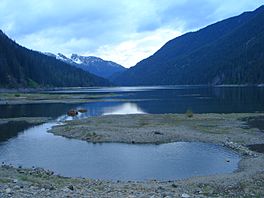Kachess Lake facts for kids
Quick facts for kids Kachess Lake |
|
|---|---|
 |
|
| Location | Kittitas County, Washington, United States |
| Coordinates | 47°15′51″N 121°12′21″W / 47.26417°N 121.20583°W |
| Type | reservoir, natural lake |
| Primary inflows | Kachess River |
| Primary outflows | Kachess River |
| Catchment area | 63 sq mi (160 km2) |
| Basin countries | United States |
| Max. length | 9.6 mi (15.4 km) |
| Max. width | 1.2 mi (1.9 km) |
| Max. depth | 430 feet (130 m) |
| Water volume | 238,000 acre-feet (294,000,000 m3) |
| Surface elevation | 2,254 ft (687 m) |
Kachess Lake is a beautiful lake and a reservoir in Washington state, USA. It's fed by the Kachess River, which also flows out of it. The northern part of the lake is even called Little Kachess Lake. Kachess Lake is special because it's one of three big lakes near Interstate 90 in the amazing Cascade Range. The other two lakes are Cle Elum Lake and Keechelus Lake.
Contents
What is Kachess Lake?
Kachess Lake is a natural lake that has been changed to also work as a reservoir. A reservoir is like a big storage tank for water. The lake is part of a larger water system called the Columbia River basin. The Kachess River flows into the lake, then flows out and joins the Yakima River. The Yakima River then flows into the mighty Columbia River.
Where is Kachess Lake?
You can find Kachess Lake in Kittitas County, Washington. It's located in the middle of three large lakes. These lakes are found north of the Yakima River in the Cascade Range mountains. Kachess Lake is right between Cle Elum Lake to the east and Keechelus Lake to the west.
Why is it Important?
Kachess Lake is very important because it stores water for the Yakima Project. This project is run by the United States Bureau of Reclamation. Its main job is to provide water for farming, also known as irrigation.
The Yakima Project
Even though Kachess Lake is a natural lake, its water levels are controlled by a special structure called Kachess Dam. This dam is 115 feet (about 35 meters) tall and was built in 1912. It's made of earth, which means it's built from soil and rocks. The dam helps to hold back water, making sure there's enough for the Yakima Project.
The dam helps to store a lot of water. It can hold about 239,000 acre-feet of water. An acre-foot is the amount of water needed to cover one acre of land with water one foot deep. That's a huge amount of water! The dam's design helps to use almost all the natural water that flows into the lake each year.
What Does the Name Mean?
The name "Kachess" comes from a Native American language. It means "more fish." This is interesting because another nearby lake, Keechelus Lake, has a name that means "few fish." So, it seems Kachess Lake was known for having lots of fish!



